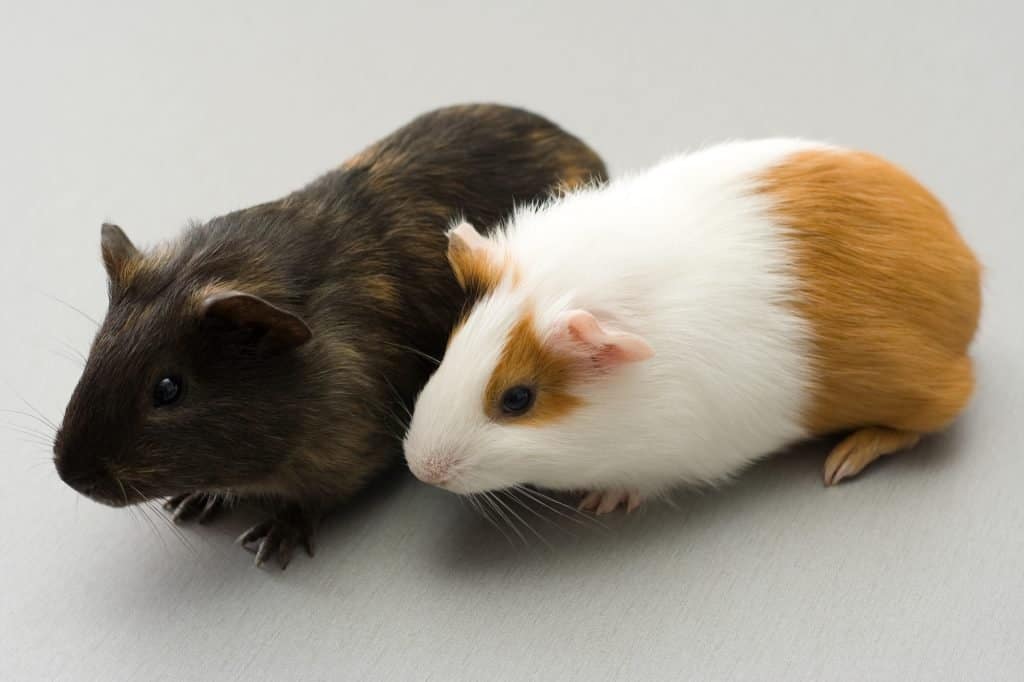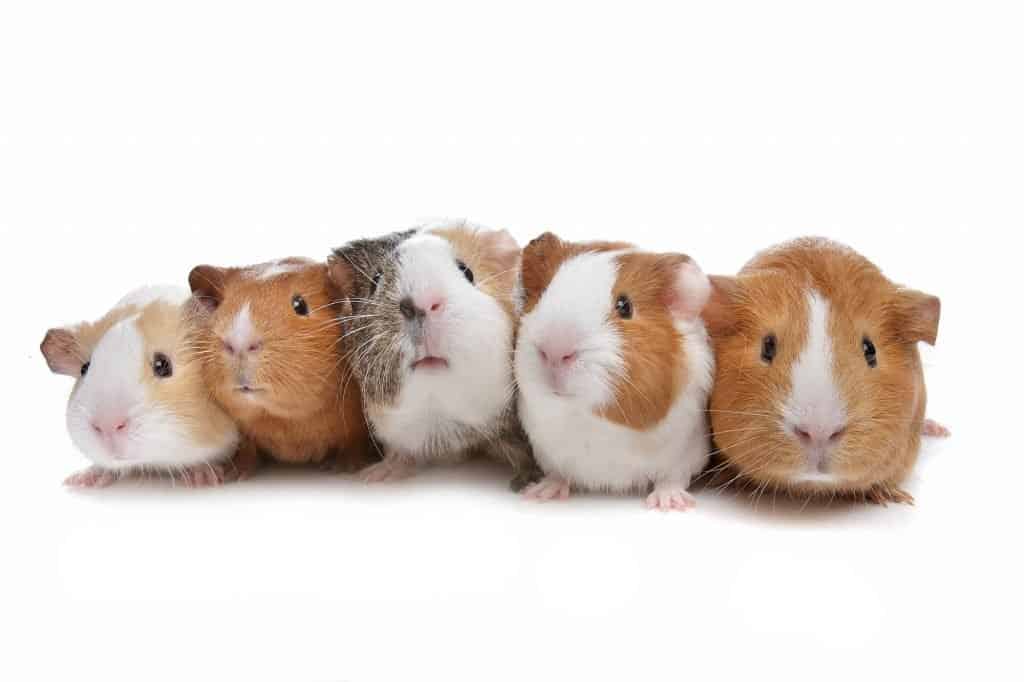Guinea pigs have become a popular small pet all over the world. If you are debating about getting a small pet such as a guinea pig, hamster, rabbit, ferret, or other small pet, you should consider how much space you need. To determine this for a guinea pig, you need may have wondered how big do guinea pigs get?
This article will dive into the size of guinea pigs over their lifetime to help you gain a better understanding.
So, How Big Do Guinea Pigs Get?
Guinea pigs do not get very large. Their size and weight depends on their breed, health, and age. The average guinea pig can grow up to 5 inches tall and between 10-14 inches long. Guinea pigs weigh between 1.5lbs and 2.5lbs on average.
Guinea pigs are small, domesticated, herbivorous rodents from South America. They have no tails, small ears, and short legs. But there is so much more to these creatures than we are aware of, and if you are thinking of getting yourself one, you are in the right place.
This article will discuss the sizes of these magnificent animals and which environments would suit their space and health needs.
Average Guinea Pig Size
The adult size of a guinea pig is the result of many factors, such as:
- Genetics
- Overall Health
- Gender
- Species
- Birth Order
- Diet
- Lifestyle
- Age
Over the years, as crossbreeding took place, many different guinea pigs were developed, which are recognized today. A guinea pig reaches about the size of a large mango when it is fully grown. However, there are various guinea pig breeds globally, and they all differ in size and appearance.
The average size of a standard guinea pig is between 7-12 inches long. This is not to mention the miniature and giant versions of guineas. Some guinea pigs have even been reported to have reached a length of 20 inches.
Males are bigger than females in general, but more complicated factors contribute to the size of a guinea pig. Genetics is the main reason for determining their small or large composition.
Average Weight And Size Of Male And Female Guinea Pigs
The average male guinea pig stands at +/-8-12 inches and weighs +/- 1000-1200grams. The average female guinea pig stands at +/-8-10 inches and weighs +/- 900-1100grams.

Guinea pigs are somewhat unique in comparison to other rodents. They grow much faster than your average hamster, rat, or mouse. They also have an accelerated growing speed and could double in size in the first month after they are born.
Like other animal litters, guinea pigs are born in different sizes to their siblings. The number of pups per litter also determines how large they will become when they are fully grown. So, the more pups in the litter, the smaller their size, and the fewer guinea pig pups in a litter, the bigger they will get.
Largest Guinea Pig Breeds
Guinea pigs in comparison to other rodents, are not small. They are actually some of the largest rodents in the world. There are, however, different size ranges of cavies.
Below is a chart of some of the largest guinea pigs:
| Name Of Guinea Pig | Size | Weight | Origin |
|---|---|---|---|
| Cornet | 8-16 inches (20-40cm) | 2-3lbs | England, mid-1970s. They are a cross between an American Crested Guinea Pig and a Silkie Guinea Pig. |
| Sheba | 7-12 inches (18-30cm) | Also known as Sheba Mini Yak, it originated in Australia and has a tousled rosette coat. | |
| Teddy | 10-12 inches (25-30cm) | 2-3lbs | The Teddy Guinea Pig originated as a result of genetic mutation. They are called “Teddy” because of their Teddybear-like coat. The place of origin is unknown. |
| Texel | 8-10 inches (20-25cm) | Originated in the early 1980s, England. They are a cross between a Curly Coated Rex Guinea Pig and a Long Haired Silkie Guinea Pig. | |
| Lunkarya | 5-12 inches (13-30cm) | 1-2lbs | The name Lunkarya derives from "Lundquist" (the surname of the people who developed the breed) and "rya," meaning 'sheep' in Swedish, with Sweden being its place of origin. They are known for their long, disheveled coat and “bad hair days” look. |
| Peruvian | 10-14 inches (25-35cm) | 2-3lbs | Originating from Argentina of Peru, Peruvian Guinea Pigs are one of the oldest guinea pig breeds, dating back to the late 1800s. |
| Ridgeback | 10-12 inches (25-30cm) | 1-3lbs | Ridgebacks originated in America (the exact year of origin is unknown). Their name is given to them due to the hair on their back, starting from their ears, all along the length of their spine. This ridge stands at 2.5 cm high. |
| Abyssinia | 10-14 inches (25-35cm) | 1.8-3lbs | Although the exact origin is unknown, Abyssiniah Guineas are believed to have originated from South America. Famous for its unique cowlicked, swirly hair, the Abyssiniah Guinea Pig is one of the oldest guinea pig breeds in the world. |
| Himalayan | 8-10 inches (20-25cm) | 1.55-2.4lbs | Himalayan Guinea Pigs originated in South America. They are naturally albino as they are born pure white. Their pigment only starts to develop as they age but remains pale in color. |
| Rex | Up to 17 inches | Up to 4lbs | The winner in the size contest goes to the Rex Guinea Pig. They reach an incredible length of 43cm, and there has been no other breed reported to be larger than the Rex! These guinea pigs originated in South America in 1200AD, making them the largest and the oldest guinea pigs in the world! |
How Big Are Guinea Pigs When They Are Born?
Guinea Pigs are tiny when they are born. They weigh between 0.13-0.26lbs and are only 3-6 inches long. But they grow at a rapid rate. The average birth weight is 2.8 ounces, depending on the litter size and birth order.
When a baby guinea pig reaches one year of age, it will be fully grown in length and weight.
What Is The Best Cage Size For A Guinea Pig?
See the chart below to determine the minimum size cage you should purchase for the number of guinea pigs you have or are thinking about getting.
| Amount Of Guinea Pigs | Recommended Cage Size |
|---|---|
| 1 guinea pig | 7.5 - 9 square feet |
| 2 guinea pigs | 9 - 10 square feet |
| 3 guinea pigs | 11.5 - 12.5 square feet |
| 4 guinea pigs | 13.5 - 14.5 square feet |
| 5 guinea pigs | 16 - 17 square feet |
One of the things to consider, is that if you can it is best to keep guinea pigs in pairs. Guinea pigs are social animals and tend to do better and live longer with company than alone.
So if you are starting with one guinea pig but eventually plan to welcome another one into your family, you should purchase a cage capable of holding two guinea pigs.
Importance of Cage Size for Guinea Pigs
There are many benefits to keeping your guinea pigs in a larger cage, they are as follows:
- Better smelling guinea pigs! Excretion build-up is a big problem and can be significantly reduced if they have a larger space to live in. It will allow them to defecate in specific cage areas, and they won’t end up sleeping and playing in their droppings.
- A bigger cage creates a more harmonious environment. They are territorial animals, and if they have more space, there will be less fighting if you have more than one cavy.
- Guinea pigs are used to vast spaces, and cramming them into small cages makes them sad, depressed, and frustrated.
- Their lifespan will be extended because when guinea pigs live in larger areas live longer due to better health and more exercise. The average guinea pig life span is 4-7 years. A large cage will get you closer to the seven years.
Conclusion
Guinea pigs come in many shapes and sizes. They are fantastic with their cute hairdos and make wonderful pets for children. However, it is essential to create the right environment for them to live in. So, now that you know how big these fantastic creatures can get, you can make an informed decision on how much space you need and what size crate to get for your new friend.
Be sure to research the specific types of guinea pigs you plan to get and their sizes to make you can select the correct housing for their full adult size.

